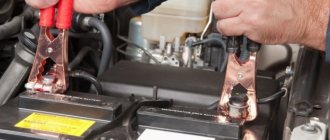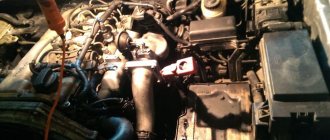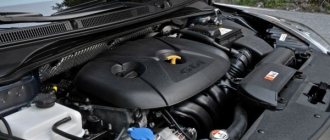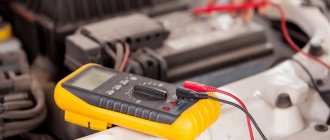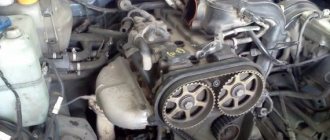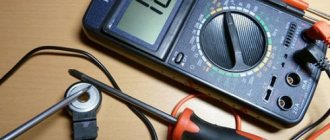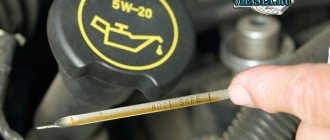There are many devices that use a source of stored electrical energy - a battery. It is used everywhere, from cell phones, electronic watches, calculators, flashlights, life support systems and to vehicle engine starting systems. About electric storage devices, how different types of such power sources differ, what important characteristics of the battery you need to know, and the safety rules for its use will be discussed further.
What is self-discharge of a car battery?
The battery cannot be ready to start the engine for an infinite amount of time. This is due to the peculiarities of the physical and chemical phenomena occurring inside. Over time, self-discharge occurs under the hood of a car battery, so without restoration it will produce less and less performance.
The phenomenon of self-discharge is, in chemical terms, the dissolution of lead on the positive electrode (with parallel release of hydrogen) when the electrical charge of the power source is lost.
During self-discharge on a negatively charged electrode, sulfuric acid interacts with lead oxide. The process is accompanied by the release of oxygen gas. It will not be possible to completely get rid of the gradual loss of charge in lead-acid batteries, but in certain circumstances it is possible to significantly extend the reaction rate over time.
Energy consumption is influenced by the following factors:
- The period of active operation of the battery. For power supplies operating for more than three years, the risk of self-discharge increases significantly.
- The duration of storage outside the car and connection to the on-board network increases the self-discharge current.
- Used impurities and mechanical/chemical debris, causing the dissolution of lead elements on the positive contact. The culprit may be undistilled water, which was poured in to raise the electrolyte level in the jars.
- Energy is lost more actively when the temperature rises above +50 C.
- Frequent reasons that lead to leaks are moisture and dirt that appears on the battery body.
- Mechanical and physical destruction of lead electrodes.
Purpose of the battery in a car
The main functions that a car battery is designed to perform are to start the car engine and also provide current to some consumer devices. This is a current source that is renewable, that is, the battery capacity can and should be restored if it is in good condition. Each battery converts electricity into chemical energy, and subsequently this process occurs in the reverse order.
This device is most in demand at the stage of starting an internal combustion engine. However, the battery is also responsible for the operation and power of all electrical equipment on board the vehicle. As soon as the engine is started, the devices are powered by the generator, which simultaneously charges the battery, because each start leads to a decrease in its capacity.
In recent years, cars of all brands have been actively equipped with electrical appliances, climate control systems, sound and video, and all of them are powered by on-board electrical current. If the generator cannot cope with its supply, then additional recharge is provided from the battery. However, its key task is still to supply current to start the starter. The greatest battery discharge occurs in the cold season, when most problems arise for car enthusiasts.
Types and causes of battery self-discharge
In practice, two types of self-discharge processes can be encountered:
- Surface. It is caused by the fact that there are leaks of moisture or electrolyte on the case, as well as mechanical contamination. As a result, current-conducting bridges appear connecting the battery contacts, and during self-discharge a small current appears. Getting rid of it is quite simple by removing everything by mechanical cleaning, and the terminals are treated with a protective anti-corrosion lubricant or gel.
- Interior. This type of self-discharge of a car battery is provoked by chemical reactions of reduction and oxidation that occur spontaneously on both electrodes.
You need to know that the negative electrode is most susceptible to the discharge process during storage, where the release of hydrogen gas and the dissolution of lead occur. For the positive electrode, the self-discharge process is not as active, since the reaction of lead oxide and sulfuric acid occurs with the release of oxygen gas.
As the density of the electrolyte increases (the degree of charge of the battery increases), the intensity of the reaction increases. You should know that the intensity of discharge rises by more than a third when the electrolyte density reaches from 1.29 to 1.32 g/ml.
Operating principle
Replacing the battery on an electric forklift
The operating principle of the battery is based on the reversibility of a chemical reaction. The functionality of the battery can be restored by charging, that is, by passing an electric current in the direction opposite to the direction of the current during discharge. Several batteries combined into one electrical circuit make up a rechargeable battery
.
Lead acid battery
Main article: Lead-acid battery
The operating principle of lead-acid batteries is based on the electrochemical reactions of lead and lead dioxide in a sulfuric acid solution.
Chemical reaction (from left to right - discharge, from right to left - charge):
- Anode:
P b + SO 4 2 − − 2 e − ⇆ P b SO 4 {\displaystyle Pb+SO_{4}^{2-}-2e^{-}\leftrightarrows PbSO_{4}}
- Cathode:
P b O 2 + SO 4 2 − + 4 H + + 2 e − ⇆ P b SO 4 + 2 H 2 O {\displaystyle PbO_{2}+SO_{4}^{2-}+4H^{+} +2e^{-}\leftrightarrows PbSO_{4}+2H_{2}O}
Li-ion battery
Main article: Lithium-ion battery
A lithium-ion battery consists of electrodes (cathode material on aluminum foil and anode material on copper foil) separated by porous separators impregnated with electrolyte. The charge carrier in a lithium-ion battery is a positively charged lithium ion, which is introduced (intercalated) into the crystal lattice of other materials (for example, into graphite, metal oxides and salts) to form a chemical bond (for example: into graphite with the formation of LiC6, oxides (LiMO2 ) and metal salts (LiMRON).
An aluminum-ion battery consists of a metal aluminum anode, a graphite foam cathode, and a liquid ionic non-flammable electrolyte. The battery operates on the principle of electrochemical deposition: aluminum dissolves at the anode, then chloroaluminate anions intercalate into graphite in a liquid electrolyte environment. The number of possible battery recharges is more than 7.5 thousand cycles without loss of power[2][3].
How to check self-discharge
It will be possible to identify battery problems in garage conditions, including possible self-discharge, using indirect signs. One of the important assistants in such a situation is a multimeter. This device helps to measure almost all important characteristics of the battery, for example, it will help you find out the voltage or current in the connected on-board network.
To work with a battery, the multimeter must be switched to voltmeter mode and switched to 20 units. We connect the red positive wire to the positive terminal on the battery, and the black (or blue in some models) to the negative terminal on the power source.
We recommend taking measurements after the car has been standing for about an hour without moving in order to obtain the most objective indicators. When the numbers on the display are 12.4 V or more, this indicates a full charge. With values of 11.7–12 V, you should prepare for a deterioration in the performance of the battery, and if the readings are close to 11 V, then this is evidence of serious problems with the battery.
We recommend checking the internal resistance. A 12V incandescent lamp (not LED) is used for testing. While connecting its contacts, we simultaneously measure the voltage at the terminals. We fold it back and take the measurement again. If the difference does not exceed 0.05 V, then the battery is working, otherwise the battery has problems.
Application
In most cases, the possibility of systematically using batteries is only possible in portable radio communication devices and other digital equipment, where lithium-ion batteries are used and the charge-discharge control system is built into the device. In the budget segment, “simple” nickel-metal hydride and nickel-cadmium batteries are used as a budget replacement for alkaline batteries. Nickel-cadmium batteries are used as a current source for budget cordless power tools.
If in the first case it is usually possible to choose between a budget device of a “standard” charge and a charger with charge control (drop charge, pulse charge, accelerated charge with voltage control, etc.), then in the second case the product is usually equipped with with a transformer power source for direct current charging, which, if the technical operating conditions of the battery are not observed, reduces its service life.
Allowable self-discharge size
At a time when the battery is not affected by negative factors, energy should be consumed minimally. Such self-discharge of your car battery is the norm. Favorable temperatures are in the range from +5 to +150 C with minimal humidity.
The voltage drop values for a new battery and for one that has been in use for a long time will be significantly different.
When the self-discharge per day for an “old” battery is 1–1.7%, many experts consider this value to be normal. More accurate values depend on the brands, age, conditions in which the battery is used, etc. Sometimes even a battery that is not the oldest can lose its charge faster under intensive use.
Accordingly, in a couple of weeks, a 10% loss of charge for a new power source will be within acceptable limits. A three-year-old can completely lose its charge in a hundred days without load.
Specifications
The scope of application of the battery is greatly influenced by the technical characteristics of the battery. The most important of them:
- capacity,
- output energy density,
- battery voltage,
- how far it can be discharged before further charging is impossible,
- life time,
- working temperature,
- self-discharge rate,
- output current,
- dimensions and weight,
- type of execution.
Now more details.
Capacitance, voltage and current
Main characteristics of the battery:
- Battery capacity - how much energy it can store. Measured in ampere hours (often labeled mAh). In other words, 2000 mAh for example means that the battery will last 2000 hours, using 1 milliamp per hour, at 12V. When consuming 100 milliamps, 12V, the drive will only work for 20 hours.
The operation of a battery can be explained in a similar way to a water tank. There is a tank (battery), a pipe of a fixed diameter (volts) comes from it, the stronger the pressure or otherwise the pressure of the outgoing stream through the pipe (amps), the faster the tank (battery) will run out.
Overcharging the battery may cause self-destruction.
- Battery voltage - how many maximum volts the battery produces when fully charged. As the battery discharges, the output voltage decreases.
- Current strength is the maximum value of battery discharge current that the battery can produce over a certain period of time. If you exceed it, for example, by a short circuit between the terminals, then the consequences are unpredictable. For example, lithium ion batteries overheat greatly and can simply explode.
Operating temperature range
Any manufacturer indicates the lifespan, the amount of current supplied, and the voltage for the ideal temperature regime. The connection occurs directly to the speed of chemical reactions. Lower the temperature - they pass slower, the drive discharges faster. When heated, on the contrary, the discharge rate decreases.
Self-discharge of batteries
Any energy storage device is subject to self-discharge. Fully charged, it gradually loses charge, even when disconnected from current sources. This is due to the chemical processes occurring inside, which, even if there is no current consumption, continue. They just go slower. Even a battery without a load contains an electrical connection through the electrolyte between the electrodes. All the same, internal exchange of ions of substances occurs, causing self-discharge.
Different chemical types of electrical energy storage devices are susceptible to this process in different ways. The leaders are nickel-iron, which lose 15% of their charge during a month of storage without load. Lithium-ion models retain stored energy for the longest time; they require about 2%.
Allowable discharge depth
Any battery that stores electricity consists of many pairs of plates electrically connected in series. If you completely discharge any pair to zero, it will change the poles and begin to transfer current back (of course, the current strength will be much less). This happens due to the course of chemical reactions, because the operating principle of any power source is ion exchange. When the cathode plate collects enough ions, and the anode plate loses too many of them, the reverse transfer process will begin, in other words, the anode will become a cathode, and the cathode will become an anode. What does this mean for the entire battery? The electrical circuit is broken, after which the drive stops producing current. Accordingly, the entire battery will stop working.
To prevent such a situation, modern power supplies contain a microcircuit that limits the current of complete battery discharge, cutting off the consumer when a certain threshold level is reached. Such batteries are especially common when supplied with various high-tech devices (for example, smartphones, cell phones).
Note! Perhaps some people are familiar with the situation when a cell phone battery “died”. So the reason for this is the power controller. If the remaining energy is too small for the microcircuit to operate, then the power supply will remain blocked, since the controller simply will not give a signal that opens the consumer connection circuits.
Life time
A battery is a chemical element whose service life is limited. Over time, the reducing chemical reactions that occur under the influence of current weaken, and the elements begin to lose capacity, becoming completely depleted. The most indicative devices contain liquid electrolyte. Actually, their conductive liquid is an alkaline or acidic solution, which also destroys the structure of the metal plates. Among other things, ongoing chemical reactions reduce the density of the solution, reducing the force of impact. Lead-acid ones last a maximum of 7 years. Lithium ion 7-20. The most durable are nickel-cadmium. Service life - 25 years.
There is a small nuance. The service life is usually indicated for ideal conditions, with correct discharge-recharge cycles, operation at room temperature with uniform current flow. The actual lifespan is much lower. Especially for Li-Ion drives. Wearable devices constantly change temperature environments (street, house), and charge incorrectly (no one waits for 25% discharge to charge). Automotive engine starting systems are also constantly exposed to temperature changes. True, lead batteries are not so susceptible to environmental influences.
Form factors
Charge storage cells come in different types of form factors. There are separate and built-in options. It all depends on the lifespan of the chemical type of the element. If the manufacturer has decided that the service life of a device will be equal to the battery life, the battery will be built-in. Other cases involve replacing batteries that have exhausted their service life.
Dimensions and weight
An important characteristic of a battery is its weight. Often, the capacity, including the amount of current supplied (amps), its volts directly depends on the size of the bundle of electrode pairs itself. In addition, weight and volume are tied to the type of chemical processes with the materials used to make the plates. For example, lead plates, immersed in electrolyte with a common body, will be much heavier than an assembly of aluminum and copper foil with a wet layer between them.
The reason why there is no production of automotive molded batteries is the high price relative to the capacity. Another factor is sensitivity to temperature changes.
How to reduce self-discharge
There are several ways to help the battery reduce charge leakage. If you follow them, the battery will be able to maintain the required performance for a long time.
It is important to keep the device clean and fill in distilled water in a timely manner for serviced models. It is worth wiping the case with a dry cloth to remove possible moisture, dust or deposits. Before sending the battery to idle time, we recommend charging it as much as possible, and then monitoring the voltage at the terminals at least once a month, avoiding deep discharge.
